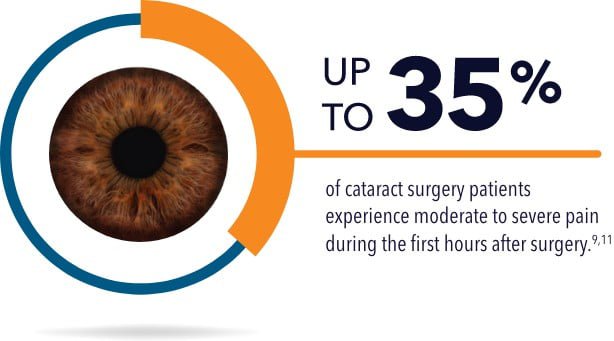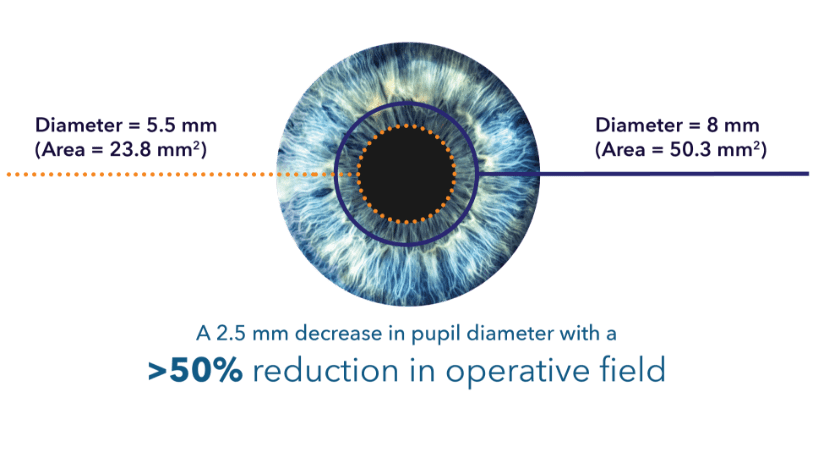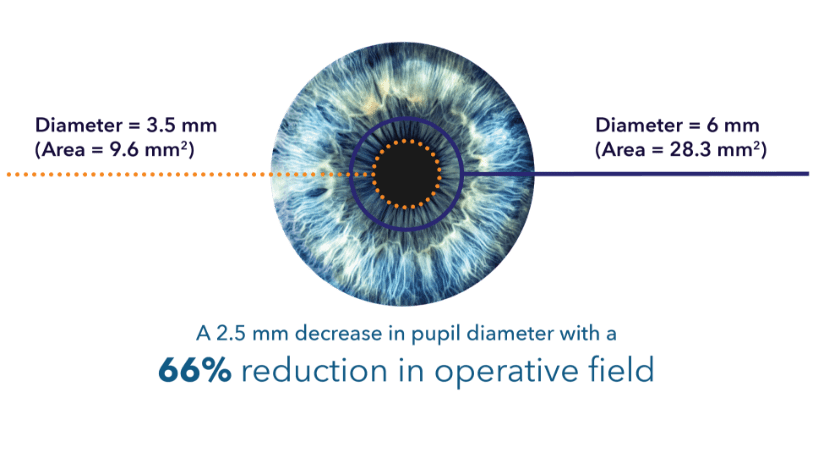MIOSIS CAN OCCUR AT ANY TIME DURING CATARACT SURGERY
Miosis is unpredictable, even in patients who do not have risk factors that can lead to surgical complications.2,3
Unplanned events can lead to a cascade of complications2,4-9

Despite your best efforts, miosis during cataract surgery can result in7,8,10:

The need for pupil expansion devices

More frequent surgical complications

Increased surgical time
IFIS is unpredictable2
- Progressive intraoperative miosis, iris prolapse, or iris billowing can occur without warning during any stage of cataract surgery

Despite your best efforts, miosis during cataract surgery can result in7,8,10:
The need for pupil expansion devices
More frequent surgical complications
Increased surgical time
IFIS is unpredictable2
- Progressive intraoperative miosis, iris prolapse, or iris billowing can occur without warning during any stage of cataract surgery
Inflammation and pain can compromise your cataract surgery performance

![]()
Intraoperative pain and irritation can impact patient satisfaction
87% of patients reported intraoperative pain during second-eye surgery11
Intraoperative pain and irritation can impact patient satisfaction
87% of patients reported intraoperative pain during second-eye surgery11
REFERENCES: 1. Visco D. Effect of phenylephrine/ketorolac on iris fixation ring use and surgical times in patients at risk of intraoperative miosis. Clin Ophthalmol. 2018;12:301-305. 2. Chang DF, Campbell JR, Colin J, Schweitzer C; the Study Surgeon Group. Prospective masked comparison of intraoperative floppy iris syndrome severity with tamsulosin versus alfuzosin. Ophthalmol. 2014;121(4):829-834. 3. Roach L. Strategies for preventing intraoperative miosis. EyeNet. June 2015:29-31. 4. Visco DM, Bedi R. Effect of intracameral phenylephrine 1.0%‑ketorolac 0.3% on postoperative cystoid macular edema, iritis, pain, and photophobia after cataract surgery. J Cataract Refract Surg. 2020;46(6):867-872. 5. Rosenberg ED, Nattis AS, Alevi D, et al. Visual outcomes, efficacy, and surgical complications associated with intracameral phenylephrine 1.0%/ketorolac 0.3% administered during cataract surgery. Clin Ophthalmol. 2018;12:21-28. 6. Al-Hashimi S, Donaldson K, Davidson R, et al. Medical and surgical management of the small pupil during cataract surgery. J Cataract Refract Surg. 2018;44(8):1032-1041. 7. Hovanesian JA, Sheppard JD, Trattler WB, et al. Intracameral phenylephrine and ketorolac during cataract surgery to maintain intraoperative mydriasis and reduce postoperative ocular pain: integrated results from 2 pivotal phase 3 studies. J Cataract Refract Surg. 2015;41:2060-2068. 8. Akman A, Yilmaz G, Oto S, Akova YA. Comparison of various pupil dilatation methods for phacoemulsification in eyes with a small pupil secondary to pseudoexfoliation. Ophthalmol. 2004;111:1693-1698. 9. Porela-Tiihonen S, Kaarniranta K, Kokki H. Postoperative pain after cataract surgery. J Cataract Refract Surg. 2013;39:789-798. 10. Osher RH, Ahmed IIK, Demopulos GA. OMS302 (phenylephrine and ketorolac injection) 1%/0.3% to maintain intraoperative pupil size and to prevent postoperative ocular pain in cataract surgery with intraocular lens replacement. Expert Rev Ophthalmol. 2015;10(2):91-103. 11. Jiang L, Zhang K, He W, Zhu X, Zhou P, Lu Y. Perceived pain during cataract surgery with topical anesthesia: a comparison between first-eye and second-eye surgery. J Ophthalmol. 2015;383456:1-6.

